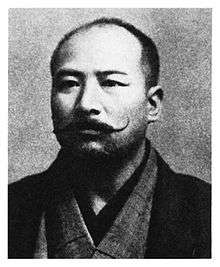Yokoyama Sakujiro
| Yokoyama Sakujirō 横山 作次郎 | |
|---|---|
 Yokoyama Sakujirō, the Guardian of the Kōdōkan. | |
| Born |
1864 Tokyo, Japan |
| Died | September 23, 1912 (aged 48) |
| Native name | 横山 作次郎 |
| Nationality |
|
| Style | Tenjin Shinyo ryu, Judo |
| Teacher(s) | Kanō Jigorō |
Yokoyama Sakujirō (横山 作次郎, 1864 – September 23, 1912), was one of the earliest disciples of Kanō Jigorō.[1]
Biography
Yokoyama was born in Saginomiya, Tokyo, Japan in 1864. He was a student of Tenjin Shin'yō-ryū jujutsu under Inoue Keitaro (井上 敬太郎) in the Yushima Tenjin (湯島 天神) dojo, but also trained in Kitō-ryū. He joined the police in Yamagata prefecture and became a student of Daitō-ryū Aiki-jūjutsu in the dojo of Takeda Sokaku (武田 惣角). Yokoyama was 22 when he entered the Kōdōkan dojo in April, 1886.[2] He is believed to have come originally to the Kodokan as a challenger, pledging himself to Kano's teachings after being bested by Saigō Shirō.[3] Yokoyama further assisted Kano in establishing the Kōdōkan.[4] In 1886, he competed in a famous match against Ryoi Shinto-Ryu jujutsu Hansuke Nakamura, who was considered the toughest martial artist in Japan. The match lasted 55 minutes and saw the referee forcefully separating the fighters at the end by prying their fingers apart.[3] Yokoyama was awarded the seventh grade in October, 1904, which was the highest dan in judo at the time. He was considered the most formidable of all judo experts of his time, which reflected in his nickname of Demon Yokoyama (鬼横山 Oni Yokoyama).[5]
Four Guardians of the Kōdōkan
When Kanō Jigorō began developing judo from jujutsu, practitioners of jujutsu opposed his efforts. However, Kano drew a loyal following that included exceptional fighters. Hence the term "Four Guardians of the Kōdōkan" came into existence referring to Yokoyama Sakujirō along with Yamashita Yoshiaki, Tsunejirō Tomita, and Saigō Shirō.[6]
References
- ↑ Moshe Feldenkrais; Elizabeth Beringer (17 August 2010). Embodied Wisdom: The Collected Papers of Moshe Feldenkrais. North Atlantic Books. pp. 140–141. ISBN 978-1-55643-906-3. Retrieved 26 August 2011.
- ↑ "横山作次郎の墓" (in Japanese). Retrieved 2011-08-26
- 1 2 John S. Nash (2012-12-08). "The Forgotten Golden Age of MMA – Part II: The Rise of Judo & the Dawn of a New Age". Cage Side Seats. Retrieved 2016-04-28.
- ↑ Brian N. Watson (3 October 2008). Judo Memoirs of Jigoro Kano. Trafford Publishing. p. 187. ISBN 978-1-4251-6349-5. Retrieved 26 August 2011.
- ↑ Ernest John Harrison (1955). The fighting spirit of Japan: the esoteric study of the martial arts and way of life in Japan. Foulsham. Retrieved 26 August 2011.
- ↑ Takahashi, Masao (May 3, 2005). Mastering Judo. Human Kinetics. pp. iv. ISBN 0-7360-5099-X.